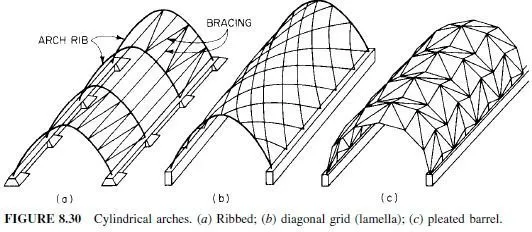The ease of erection of suspension bridges is a major factor in their use for long spans. Once the main cables are in position, they furnish a stable working base or platform from which the deck and stiffening truss sections can be raised from floating barges or other equipment below, without the need for auxiliary falsework. For the Severn Bridge, for example, 60-ft box-girder deck sections were floated to the site and lifted by equipment supported on the cables.
Until the 1960s, the field process of laying the main cables had been by spinning (Art. 15.12.3). (this term is actually a misnomer, for the wires are neither twisted nor braided, but are laid parallel to and against each other.) The procedure (Fig. 15.68) starts with the hanging of a catwalk at each cable location for use in construction of the bridge. An overhead cableway is then installed above each catwalk. Loops of wire (two or four at a time) are carried over the span on a set of grooved spinning wheels. These are hung from an endless hauling rope of the cableway until arrival at the far anchorage. There, the loops are pulled off the spinning wheels manually and placed around a semicircular strand shoe, which connects them by an eyebar or bolt linkage to the anchorage (Fig. 15.33). The wheels then start back to the originating anchorage. At the same time, another set of wheels carrying wires starts out from that anchorage. The loops of wire on the latter set of wheels are also placed manually around a strand shoe at their anchorage destination. Spinning proceeds as the wheels shuttle back and forth across the span. A system of counterweights keeps the wires under continuous tension as they are spun.
The wires that come off the bottom of the wheels (called dead wires) and that are held back by the originating anchorage are laid on the catwalk in the spinning process. The wires??passing over the wheels from the unreelers and moving at twice the speed of the wheels, are called live wires.
As the wheels pass each group of wire handlers on the catwalks, the dead wires are temporarily clipped down. The live wires pass through small sheaves to keep them in correct order. Each wire is adjusted for level in the main and side spans with come-along winches, to ensure that all wires will have the same sag.
The cable is made of many strands, usually with hundreds of wires per strand (Art. 15.12).
All wires from one strand are connected to the same shoe at each anchorage. Thus, there are as many anchorage shoes as strands. At saddles and anchorages, the strands maintain their identity, but throughout the rest of their length, the wires are compacted together by special machines. The cable usually is forced into a circular cross section of tightly bunched parallel wires.
The usual order of erection of suspension bridges is substructure, pylons and anchorages, catwalks, cables, suspenders, stiffening trusses, floor system, cable wrapping, and paving.
Cables are usually coated with a protective compound. The main cables are wrapped with wire by special machines, which apply tension, pack the turns tightly against one another, and at the same time advance along the cable. Several coats of protective material, such as paint, are then applied For alternative wrapping, see Art. 15.14.

Typical cable bands are illustrated in Figs. 15.39 and 15.40. These are usually made of paired, semicylindrical steel castings with clamping bolts, over which the wire-rope or strand suspenders are looped or attached by socket fittings.
Cable-stayed structures are ideally suited for erection by cantilevering into the main span from the piers. Theoretically, erection could be simplified by having temporary erection hinges at the points of cable attachment to the girder, rendering the system statically determinate, then making these hinges continuous after dead load has been applied. The practical implementation of this is difficult, however, because the axial forces in the girder are larger and would have to be concentrated in the hinges. Therefore, construction usually follows conventional tactics of cantilevering the girder continuously and adjusting the cables as necessary to meet the required geometrical and statical constraints. A typical erection sequence is illustrated in Fig. 15.69.
Erection should meet the requirements that, on completion, the girder should follow a prescribed gradient; the cables and pylons should have their true system lengths; the pylons should be vertical, and all movable bearings should be in a neutral position. To accomplish this, all members, before erection, must have a deformed shape the same as, but opposite in direction to, that which they would have under dead load. The girder is accordingly cambered, and also lengthened by the amount of its axial shortening under dead load. The pylons and cable are treated in similar manner.
Erection operations are aided by raising or lowering supports or saddles, to introduce prestress as required. All erection operations should be so planned that the stresses during the erection operations do not exceed those due to dead and live load when the structure is completed; otherwise loss of economy will result.



